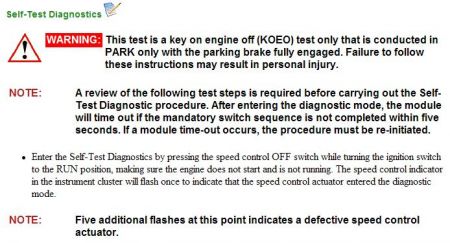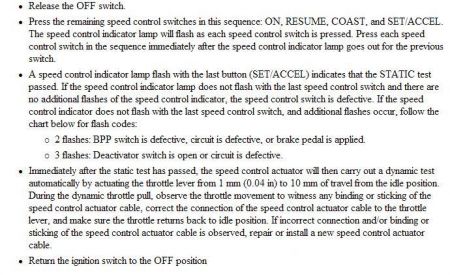Verify the speedometer operates correctly. If the speedometer does not operate correctly, check for codes
Verify the stoplamps operate correctly by pressing the brake pedal. If the stoplamps do not operate correctly, check and fix as needed
Verify the horns operate correctly by pressing the horn switch. If the horns do not operate correctly,
suspect and check clockspring
Visually inspect for obvious signs of mechanical and electrical damage.
If the fault is not visually evident, go to the SELF-TEST DIAGNOSTICS.
Self-Test Diagnostics
WARNING:This test is a key on engine off (KOEO) test only that is conducted in PARK only with the parking brake fully engaged. Failure to follow these instructions may result in personal injury.
NOTE:A review of the following test steps is required before carrying out the Self-Test Diagnostic procedure. After entering the diagnostic mode, the module will time out if the mandatory switch sequence is not completed within five seconds. If a module time-out occurs, the procedure must be re-initiated.
Enter the Self-Test Diagnostics by pressing the speed control OFF switch while turning the ignition switch to the RUN position, making sure the engine does not start and is not running. The speed control indicator in the instrument cluster will flash once to indicate that the speed control actuator entered the diagnostic mode.
NOTE:Five additional flashes at this point indicates a defective speed control actuator.
Release the OFF switch.
Press the remaining speed control switches in this sequence: ON, RESUME, COAST, and SET/ACCEL. The speed control indicator lamp will flash as each speed control switch is pressed. Press each speed control switch in the sequence immediately after the speed control indicator lamp goes out for the previous switch.
A speed control indicator lamp flash with the last button (SET/ACCEL) indicates that the STATIC test passed. If the speed control indicator lamp does not flash with the last speed control switch and there are no additional flashes of the speed control indicator, the speed control switch is defective. If the speed control indicator does not flash with the last speed control switch, and additional flashes occur, follow the chart below for flash codes:
2 flashes: BPP switch is defective, circuit is defective, or brake pedal is applied.
3 flashes: Deactivator switch is open or circuit is defective.
Immediately after the static test has passed, the speed control actuator will then carry out a dynamic test automatically by actuating the throttle lever from 1 mm (0.04 in) to 10 mm of travel from the idle position. During the dynamic throttle pull, observe the throttle movement to witness any binding or sticking of the speed control actuator cable, correct the connection of the speed control actuator cable to the throttle lever, and make sure the throttle returns back to idle position. If incorrect connection and/or binding or sticking of the speed control actuator cable is observed, repair or install a new speed control actuator cable
Return the ignition switch to the OFF position
Thursday, January 21st, 2010 AT 6:08 PM

